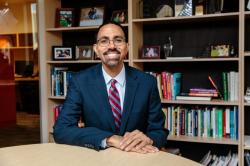

10:30 am EDT - 11:30 am EDT
Past Event
COVID-19 has laid bare the structural inequalities in many countries, especially in education. Education is perhaps one of the main mechanisms for societies to reduce inequality and for individuals to live healthy, productive, and fulfilling lives.
Around the world, the impact of school closures on student learning will vary by socioeconomic status and the extent to which schools can provide quality education remotely. While Finland and the United States are on their face both wealthy nations, they have different levels of structural inequality and have historically approached educational opportunity with distinct policy lenses. Given the contrasts, it is not surprising that they made different decisions regarding school closures and reopening in light of COVID-19.
On June 25, the Center for Universal Education hosted a webinar to contrast the Finnish and U.S. approaches to providing quality education for learners of all races, backgrounds, and income levels before and during the pandemic. Emiliana Vegas, senior fellow and co-director of the Center for Universal Education, moderated a conversation between Li Andersson, minister of education of Finland, and John B. King, CEO of Education Trust and former U.S. Secretary of Education, on how differences in policies to ensure educational opportunity between the two countries may affect structural inequality.
Below are the key themes that emerged during the conversation.
As Stanford Professor Eric Hanushek and co-authors put it, “a country’s development depends on its economic growth, and countries that foster high levels of skills in their population will thrive in the long term.” Minister Andersson emphasized the importance of education in making Finland into the country it is today. She explained that in the beginning of the 19th century, Finland was one of the least-developed countries in Europe—just a hundred years later, it is on top of different evaluations of well-being globally. (Finland has ranked at the top of the World Happiness Report in 2018, 2019, and 2020).
A systemic strength of the Finnish education system is the role of teachers’ education. In Finland, teachers are required to have a Master’s degree in their field, they earn a good salary for the work they do, and the profession is highly regarded and in high demand. (As this recent Hechinger Report article put it, “In Finland it’s easier to become a doctor or lawyer than a teacher”). Can COVID-19 lead to a renewed valuation of the teaching profession in the U.S.? King explained that the U.S. should invest a lot more in teacher preparation, learning from Finland’s work to make teacher preparation rigorous, evidence-based, and at a high bar to entry. He hopes the pandemic will lead to a greater appreciation for early childhood educators, as even affluent families have realized how vulnerable they are without quality childcare for their young children.
The differences in learning outcomes between schools are among the smallest in Finland of all the countries that have participated in the OECD’s PISA evaluation. Minister Andersson explained that small differences between schools means that parents and students can trust the school closest to their home, in their own neighborhood, so there is no need to send children away from home to get a good quality education. The performance gap between affluent and poor students in the last PISA evaluation (2018) in the U.S. was large, or 99 score points, compared to the OECD average of 89. The average performance gap between Finnish affluent and poor students was only 79 score points.
The U.S. has schools that provide incredible opportunities for some students, while others struggle tremendously to provide an adequate education. Secretary King explained that across the country, the U.S. provides the least to the students who need the most, and in particular, to low-income students and students of color who are least likely to have access to quality early childhood education. These students are less likely to be assigned to the strongest teachers, and their schools have, on average, significantly lower levels of spending and lack access to counselors, post-secondary transition support, advanced coursework, and subject areas such as science, and social studies, and the arts. The consequences are great disparities in college enrollment and completion, and in the labor market, where the unemployment rate for African Americans and Latinos is often significantly higher than it is for whites.
Recent data from a new weekly Household Pulse Survey from the U.S. Census Bureau found that children’s access to online learning is strongly correlated with race: 8.7 percent of Black respondents say their children rarely or never have access to a device for learning, four percentage points higher than for the full sample including all races. Similarly, 6.7 percent of Black respondents say there is rarely or never internet access available in their homes, 3.1 percentage points above the full sample. King emphasized that not only were devices and internet access a challenge, but also low-resourced districts were less well prepared to switch to distance learning and provide professional development for teachers to make distance learning good and engaging. For example, a recent survey found that affluent school districts were twice as likely than poor districts to require live instruction during the COVID-19 school closures..
King highlighted that some students are in homes where there’s addiction, abuse, or domestic violence. For these students, school might be the only place where they feel safe and supported, and where they have positive relationships with adults and peers. As a country, the U.S. will need to put resources toward addressing the learning loss and socio-emotional needs, at a time when the COVID-19 economic crisis has had a devastating impact on state and local revenue. Federal leadership will need to ensure resources are prioritized to support students.
Minister Andersson explained that during the severe economic depression that Finland faced in the ’90s, the government cut back on funding for family and children services. Researchers have followed the effects of these cuts decades afterwards and found that the effects of inequality in childhood persisted into young adulthood. Given this evidence, the Finnish government introduced the Children’s Support Package to provide additional state funding for school municipalities, with the goal that all children who have a need for additional instructional support would receive it when schools reopened. Minister Andersson is working to ensure that this will not be a one-time package, but rather a sustained investment over the next decade to support the students affected by COVID-19. King expressed hope that the U.S. Congress would follow Finland and prioritize children and their education. Fingers crossed.
Moderator

Panelist


Thinley Choden
May 3, 2024

Ghulam Omar Qargha, Rachel Dyl, Sreehari Ravindranath, Nariman Moustafa, Erika Faz de la Paz
May 3, 2024

Kathy Hirsh-Pasek, Rebecca Winthrop, Sweta Shah
May 2, 2024